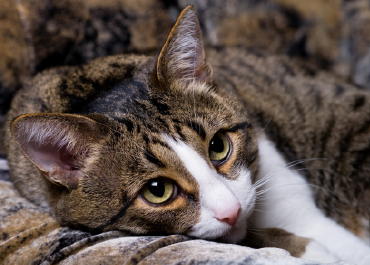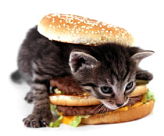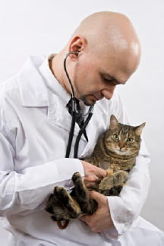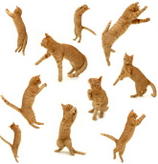Cat Illness Symptoms...is your cat ill?

Cat illness symptoms don’t crop up every day. Cats are easy to care for because food, water, clean litter and an annual visit to the vet pretty much covers it. However, the problem we face is that cats have a stoic nature. Cats inherently know by instinct that to display illness or weakness is to advertise to a predator that you are an easy target. Even though they are now domesticated (and living in a protected environment like your home) this instinct still exists.
Another of the cat illness symptoms is a decrease in appetite. A lack of appetite may occur suddenly or slowly over time. Sometimes the amount eaten changes so slowly as to be imperceptible and is only detected because of body weight loss. The amount eaten may also be concealed by the fact that two or more cats share a food bowl.
In our multi-cat household, although they all have their own bowls, periodically Max can be seen sneaking some food out of a bowl that doesn’t belong to him. Plus, when a cat is in the care of a neighbor or boarding facility, the change of food intake may go undetected.
A decrease in appetite is a reason to have your cat promptly examined by your vet. A total lack of appetite is more urgent and immediate…have your cat examined within 1 day. Common causes for this particular item in cat illness symptoms include self-limiting illnesses such as dietary indiscretion (for example – ate a bad mouse) and more serious illnesses such as feline kidney disease or cat liver disease (fatty liver syndrome).
It’s important not to “wait and see” if your cat isn’t eating at all. When the cat stops eating, the lack of food damages the liver. A vicious circle develops where the cat cannot eat because of her liver problem, but her liver gets worse because she doesn’t eat.
Cat illness symptoms include difficult urination and is often associated with the presence of blood in the urine and urinary accidents outside the litter box. Male cats may lick at the tip of the penis or become suddenly ill and develop listlessness, lack of appetite, or vomiting, or they may cry out as they attempt to pass urine.
A male cat that strains to urinate is an emergency and your veterinarian should be immediately contacted. The reason it is considered an emergency when a male cat strains is because their urethra (the canal from the bladder to the outside) is narrow and may become plugged by blood clots, debris, or urinary stones.
If the bladder cannot empty the body’s waste, products accumulate and the cat becomes sick. A blocked cat can become very ill in 24 hours and could die within 72 hours. The unblocking procedure is usually accomplished by passing a urinary catheter through the urethra to relieve the obstruction. This is most easily accomplished with early detection of the blockage.
A female cat straining to urinate should still get medical attention but is not usually associated with a complete blockage to urine flow. A female cat’s urethra is much wider and unlikely to become plugged. Urinary straining can be caused by several things such as feline lower urinary tract disease (FLUTD), bladder stones, dietary causes and bacterial urinary tract infections.
Cat illness symptoms can include skin lumps. Lumps may suddenly appear or they may have been present for years. Lumps may be associated with illness, itching, or pain or the cat may be in apparently good health. Lumps may be large or small, firm or soft, and raised or below the surface.
If you notice lumps on your cat’s skin and she is ill, take her to your vet within 24 hours. Lumps that have been present for longer than 3 months without change should be periodically re-examined by the vet. The recent discovery of a new lump should prompt veterinary attention, but is not an emergency.
Frequent causes of skin lumps include abscesses from bite wounds
(often associated with illness) and skin tumors (both benign and
malignant). Our new stray cat member, Giorgio, had lumps from claws
left in him from cat fights. He is now neutered and being converted to
an indoor cat, so this now happens less as his outdoor activities are
being curtailed. In general, a lump that rapidly changes size
necessitates swifter and more aggressive attention.
Cat illness symptoms also include excessive thirst and/or urination.
Excessive thirst may develop suddenly or slowly over time. Thirst and
ruination are often linked together; excessive water intake must be
excreted from the body, and water lost in the urine must be replenished.
Measuring how much water is actually drunk is often difficult, because many sources of water may be available or your cats may share a water bowl. Frequently the only obvious change is that the litter must be changed more frequently. If your cat has excessive thirst and/or urination, seek vet attention within a few days of its discovery.
Common causes of excessive thirst and urination include kidney disease, diabetes mellitus and elevated thyroid levels.
Another of the cat illness symptoms is weight loss. You may
notice weight loss when you handle your cat or your vet may notice at
your cat’s regular examination. One of the most important purposes of
regular vet visits is to measure and record body weight and monitor for
changes. Weight changes may not be noticed because the change has
occurred so gradually.
Weight loss is considered a serious sign of illness and should prompt attention. Common causes of weight loss include kidney disease, thyroid disease, diabetes mellitus, and cancer. Any disease that causes decreased food intake may cause weight loss.
Yet another of the cat illness symptoms is vomiting. Vomiting may occur sporadically or only after eating in both ill and healthy cats. It may also occur periodically with episodes at 1-3 week intervals. Vomiting may occur after dietary mishaps like getting into the garbage or there may be no apparent cause.
Vomiting associated with obvious illness such as lethargy and lack of appetite warrants vet attention within 8-12 hours. Vomiting due to suspected “eating garbage” may be monitored for 24 hours as long as the cat appears well otherwise. If your cat continues vomiting after 24 hours or if your cat’s appetite doesn’t return within 24 hours, consult your vet. Some cats like our Max, vomit immediately after eating, but return to the food bowl to eat more. These “gulp and vomit” cats may continue this process their entire lives yet remain healthy.
Causes of vomiting include eating garbage (or a bad mouse),
intestinal parasites, foreign objects (especially strings that become
caught in the intestines), inflammation of the stomach or intestines and
kidney, or liver or pancreatic disease.
Cat illness symptoms include problem itching. Itching may occur
only once, recur seasonally, or be continuous. Itching usually occurs
at specific areas on the body and the location of the itching implies
its cause. The sites of itching may be irritated, with bumps and hair
loss, or may be totally normal without any obvious changes. If your cat
is scratching herself, she’s probably uncomfortable, so you should seek
vet attention.
Common causes of itching includefleas (scratching at the base of the tail), ear mites (scratching at the ears), allergies (scratching at the face, ears, and/or groin), nervousness (scratching at the groin), and wounds (scratching at the site).
Another of the cat illness symptoms is diarrhea. Diarrhea frequently occurs in kittens and less commonly in adult cats. Diarrhea may be associated with illness, or the cat may appear healthy. Diarrhea may occur periodically with episodes at 1- 3 week intervals like it sometimes does with vomiting. Small amounts of fresh blood and mucus may be apparent in the stool. Because this is common with diarrhea from many causes, you needn’t be alarmed about it.
Diarrhea and lethargy in a kitten obtained within a week from a pet store or shelter should be seen on an emergency basis. Most other situations are less urgent. Diarrhea in most kittens is not associated with illness, and you can take the cat to the vet (along with a sample of the stool) on a non emergency basis. Some diseases in kittens are contagious to children, so be sure to have all the kittens examined by a vet soon after you adopt them.
Diarrhea in adult cats is seldom an emergency; only when severe lethargy is present does an adult cat need immediate attention. Diarrhea associated with dietary indiscretions (eating garbage etc.) may be monitored for 3 days as long as the cat eats and acts okay. If diarrhea is accompanied by lethargy or loss of appetite, or if it lasts longer than 3 days, visit your vet (and take a stool sample).
Common causes of diarrhea include dietary indiscretions, food changes, diabetes, intestinal parasites, and inflammation of the intestines.
Another of the cat illness symptoms is sneezing.
Sneezing may be sudden and explosive or mild and long-standing. The
cat may seem ill or healthy. She may have discharge from one or both
nostrils, and she may have discharge from her eyes and/or be squinting.
She may have been recently exposed to a new cat.
Sneezing is seldom an emergency. Violent sneezing that begins all at once should prompt vet care within 24 hours. If your cat is acting well and only clear nasal discharge is present, you can monitor her for 7-10 days to see if the problem resolves itself. But if a green, yellow, or bloody discharge develops, if appetite loss occurs, or if sneezing persists longer than 14 days, call your vet.
Common causes of sneezing include viral (caught from a new cat or when boarding), tooth root abscesses, and nasal foreign objects.
Early detection is really the best way to catch some of the cat illnesses by paying attention to the cat illness symptoms. Some of these illnesses can be safely monitored at home by an alert owner. Some signs of illness, however, may indicate a potentially life-threatening problem and may require immediate veterinarian care. Remember that early detection gives your pet the best chance of surviving serious illness. Where there is more detailed information on this site on a particular one of the cat illness symptoms, you will see a link to that page included.
Related Articles......
Return from Cat Illness Symptoms to Cat Health Homepage
Having trouble finding what you need? Cat Health Index & Site Map
OR
Do you have a question to ask?...Questions
OR
Do you have a cat story to share?...Simply click here to go to that page!
Copyright@2010-2020 All rights reserved.Cat-health-detective.com
This website is information only. Consult a veterinarian for medical assistance

"Like Us" on Facebook
or...
"Like Us" here




















